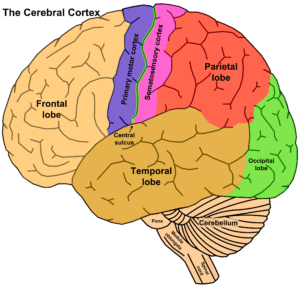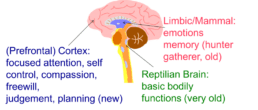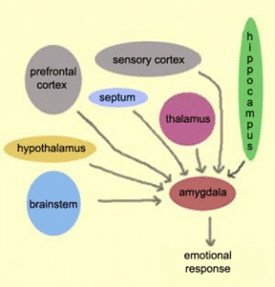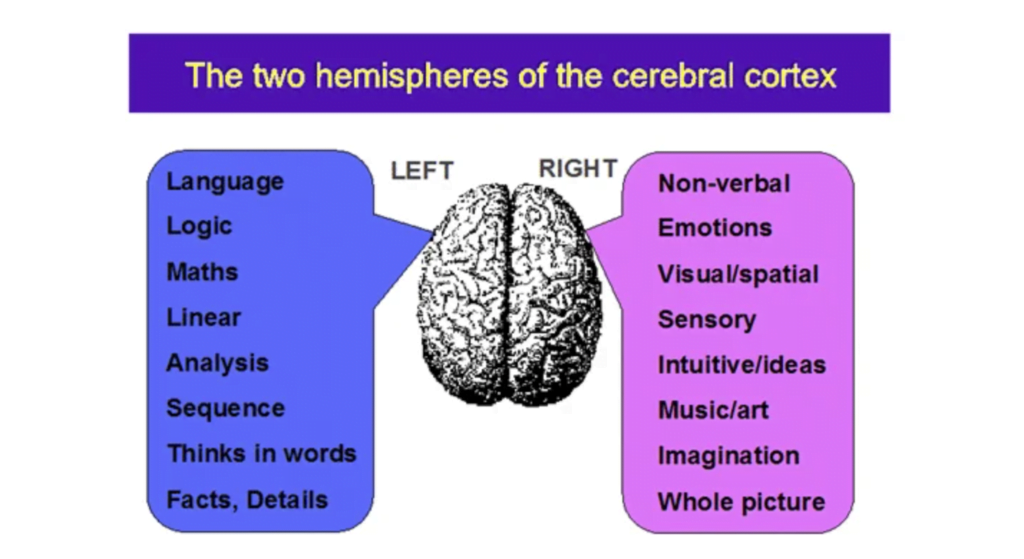Evolutionary Development of the Brain
One of the best known models for understanding brain structure is the evolutionary development of the brain model. This was developed by neuroscientist Paul MacLean and became very influential in the 1960s. Over the years since, however, several elements of this model have had to be revised in light of more recent neuroanatomical studies. It is still useful for understanding brain function in general terms. MacLean’s original model distinguished three different brains that appeared successively during evolution.
This short video by top biologist Robert Sapolsky explains the triune brain model: Why did I do that?
Here is another short video by neuroscientist and psychiatrist Dr Dan Siegel with his ‘hand‘ model of the brain explaining this concept in an easy way to remember too.
For a more formal overview of the brain’s parts and functions, enjoy this 5 minute video on the Human Brain: Major Functions and Structures.
The Reptilian Brain
This is the oldest part of the brain. It developed about 400 million years ago. It consists of the main structures found in a reptile’s brain: the brain stem and cerebellum. It is located deep within our head and fits on top of our spinal cord. It controls our most basic functions such as our heart rate, body temperature, blood pressure, breathing and balance. It also helps coordinate with the other two ‘brains’ within our head. The reptilian brain is reliable but tends to be somewhat rigid and compulsive.
The Limbic Brain. It is also called the Mammalian Brain
The limbic brain manages the body’s limbic system. It developed around 250 million years ago with the evolution of the first mammals. It can record memories of behaviours that produced agreeable and disagreeable experiences, so it is responsible for what are called ‘emotions’ in human beings. This is the part of the brain where we fall in and out of love, and bond with others. It is the core of the pleasure system or reward system in humans. Mammals, including humans, need to nurture their young for a time before they are ready to leave the ‘nest’ and fend for themselves. This is unlike most baby reptiles who just breakout of an egg and scuttle off.
The limbic brain is the seat of the beliefs and value judgments we develop, often unconsciously, that exert such a strong influence on our behaviour.
The limbic system contains six main parts – the thalamus, hypothalamus, pituitary gland, amygdala, hippocampus, nucleus accumbens and the VTA. Here are what they do.
The thalamus is the switchboard operator of our brain. Any sensory information (except for smell) that comes into our bodies goes to our thalamus first and the thalamus sends the information to the right parts of our brain to get processed.
The hypothalamus is the size of a coffee bean but may be the most important structure in our brain. It is involved in controlling thirst; hunger; emotions, body temperature; sexual arousal, circadian (sleep) rhythms and the autonomic nervous system and endocrine (hormone) system. In addition, it controls the pituitary gland.
The pituitary is often referred to as the ‘master gland’, because it produces hormones that control several of the other endocrine or hormone glands. It makes growth hormone, puberty hormones, thyroid stimulating hormone, prolactin and adrenocorticotrophic hormone (ACTH, which stimulates the adrenal stress hormone, cortisol). It also makes the fluid balance hormone called anti-diuretic hormone (ADH).
The amygdala handles some memory processing, but for the most part handles basic emotions like fear, anger and jealousy. Below is a short video by Professor Joseph Ledoux one of the most famous researchers on the amygdala.
The hippocampus is involved in memory processing. This part of the brain is important for learning and memory, for converting short term memory to more permanent memory, and for recalling spatial relationships in the world about us.
The Nucleus Accumbens plays a central role in the reward circuit. Its operation is based chiefly on two essential neurotransmitters: dopamine which promotes desire and anticipation of pleasure, and serotonin whose effects include satiety and inhibition. Many animal studies have shown drugs generally increase the production of dopamine in the nucleus accumbens, while reducing that of serotonin. But the nucleus accumbens does not work in isolation. It maintains close relations with others centres involved in the mechanisms of pleasure, and in particular, with the ventral tegmental area, also called the VTA.
Located in the mid brain, at the top of the brain stem, the VTA is one of the most primitive parts of the brain. It is the neurons of the VTA that makes dopamine, which their axons then send to the nucleus accumbens. The VTA is also influenced by endorphins whose receptors are targeted by opiate drugs such as heroin and morphine.
The Neocortex/cerebral cortex. It is also called the Neomammalian Brain
 This was the latest ‘brain’ to evolve. The cerebral cortex is divided into areas that control specific functions. Different areas process information from our senses, enabling us to see, feel, hear, and taste. The front part of the cortex, the frontal cortex or forebrain, is the thinking centre of the brain; it powers our ability to think, plan, solve problems, exercise self control and make decisions.
This was the latest ‘brain’ to evolve. The cerebral cortex is divided into areas that control specific functions. Different areas process information from our senses, enabling us to see, feel, hear, and taste. The front part of the cortex, the frontal cortex or forebrain, is the thinking centre of the brain; it powers our ability to think, plan, solve problems, exercise self control and make decisions.
The neocortex first assumed importance in primates and culminated in the human brain with its two large cerebral hemispheres that play such a dominant role. These hemispheres have been responsible for the development of human language (c 15,000-70,000 years ago), abstract thought, imagination and consciousness. The neocortex is flexible and has almost infinite learning abilities. The neocortex is what allowed human cultures to develop.
The most recent part of the neocortex to evolve is the prefrontal cortex that developed about 500,000 years ago. It is often called the executive brain. This provides us with mechanisms for self-control, planning, consciousness, rational thought, awareness, and language. It also deals with the future, strategic and logical thought and morality. It is the ‘minder’ of the older primitive brains and allows us to inhibit or put the brakes on reckless behaviour. This newer part of the brain is the part that is still under construction during adolescence.
Integrated Brain
These three parts of the brain, the Reptilian, Limbic and Neocortex, do not operate independently of one another. They have established numerous interconnections through which they influence one other. The neural pathways from the limbic system to the cortex, are especially well developed.
Emotions are very powerful and drive us from a subconscious level. Emotions are something that happen to us much more than something that we decide to make happen. Much of the explanation for this lack of control over our emotions lies in the way that the human brain is interconnected.
Our brains have evolved in such a way that they have far more connections running from the emotional systems to our cortex (the locus of conscious control) than the other way around. In other words, the noise of all the heavy traffic on the fast major highway running from the limbic system to the cortex can drown out the quieter sounds on the little dirt road running in the other direction.
The brain changes brought about by addiction include the shrivelling of the grey matter (nerve cells) in the prefrontal cortex in a process known as ‘hypofrontality’. This reduces the inhibitory signals back to the limbic brain making it almost impossible to avoid doing the behaviour that has now become both impulsive and compulsive.
Learning how to strengthen the prefrontal cortex, and with it our self-control, is a key life skill and the basis of success in life. An untrained mind or a brain unbalanced by addiction can achieve very little.




